Time Zones
Because you may move from one time zone to another, and may interact with others in other time zones, BusyCal offers flexible features for dealing with time zone differences.
All events created in BusyCal are scheduled in local time. If your system time zone is set to Eastern time, any events you create in BusyCal are in Eastern time. When you edit / view the event, the Info Panel will always show you the original time zone the event was created in. If you travel to a different time zone, or manually change your system time zone, the events you previously created in your calendar shift to reflect the new time zone - however the Info Panel will continue to show you the original time along with the original time zone it was created under.
For example, if you live in New York and your time zone settings in System Settings are set to US/Eastern time, when you create a “Dinner Meeting” at 6:00 PM, it is scheduled in your local time of 6:00 PM Eastern time. If you travel to California and change your time zone settings in System Settings to US/Pacific time, the “Dinner Meeting” appears in your calendar at 3:00 PM, because 6:00 PM Eastern time is 3:00 PM Pacific time. However when you select the event to edit it, the time will still say "6:00" with the time zone set to "Eastern Time".
If you want to avoid time shifting and ensure all your events remain assigned to the same time zone in both the calendar and the Editor/Info Panel, you have three options (plus a fourth option for situations where you’re reading this article after none of these options were used and you’ve returned home to find all your events have shifted):
- Option 1: Override Timezone in BusyCal
- Option 2: Disable automatic time zone switching in System Settings
- Option 3: Schedule events in Floating Time
- Option 4: Adjust events to Local Time Zone
Each option is described below.
Option 1: Override Timezone in BusyCal
BusyCal provides a Time Zone menu that can be used to dynamically display all the events in your calendar in a different time zone and use this same time zone for all new events you create. This is useful when traveling between different time zones where you do not want to use the System Timezone for new events. It enables your Mac’s system clock to be set to a new time zone as you travel, while BusyCal continues to display events in your home time zone.
To enable this override option, choose BusyCal > Settings > Advanced > Time Zones and check “Show time zone menu in toolbar.” You can also check “Use long time zone names” to display a city name along with the time zone.
This reveals a time zone pop-up menu in the upper-right corner of the main window above your calendar.
Assuming you live in New York (US/Eastern) and travel to California (US/Pacific), here’s an example workflow:
- Turn on the Time Zone menu in BusyCal to override and to use a fixed timezone, as described above, and choose US/Eastern from the Time Zone menu.
- While at home in New York, create events in your default local time (US/Eastern Time).
- Travel to California and change your system time zone to US/Pacific time in System Settings > Date & Time > Time Zone (this may happen automatically). This may cause all the events in your calendar to shift by 3 hours.
- In BusyCal, choose US/Eastern from the time zone menu to display all your calendar events in their originally scheduled local time.
Enable iOS Calendar Time Zone Support
The iOS built-in Calendar app (Apple Calendar) and BusyCal for iOS support time zones as well and work similarly to BusyCal for Mac. You must set your home time zone on your iOS device in Settings > Mail, Contacts, Calendars > Time Zone Override (if you use Calendar) or in BusyCal > Settings > Time Zone Override (if you use BusyCal) to match the time zone in BusyCal for Mac.
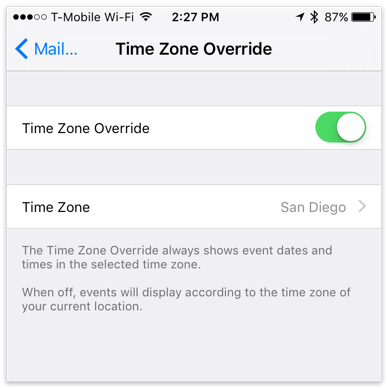
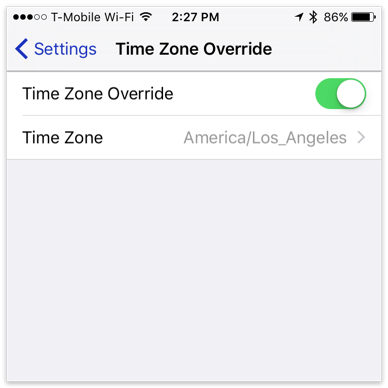
Option 2: Disable Automatic Time Zone Switching in System Settings
Your time zone is set in System Settings > Date & Time > Time Zone. By default, your Mac sets its time zone automatically using Location Services. Therefore, when you travel, your time zone settings may change without being aware of it. If your time zone settings in System Settings change, all the events in your calendar shift to reflect the new time zone. For example, if your home time zone is US/Eastern time, and your time zone settings are changed to US/Pacific time, all the events in your calendar are displayed 3 hours earlier.
You can avoid this time shifting by disabling the automatic Time Zone setting in System Settings, as follows:
- Go to System Settings > Date & Time > Time Zone.
- Deselect the “Set time zone automatically using current location” checkbox.
Enter your home location in the Closest City field.
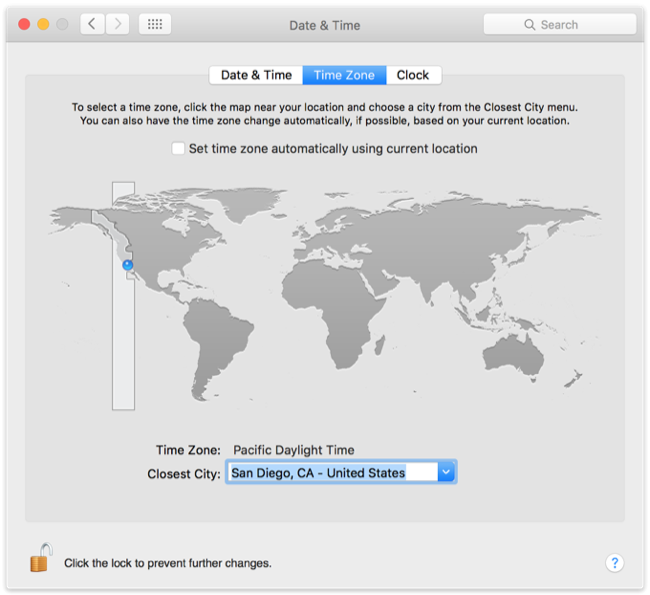
Select the Date & Time tab.
Uncheck the “Set date and time automatically” checkbox.
Manually set the time.
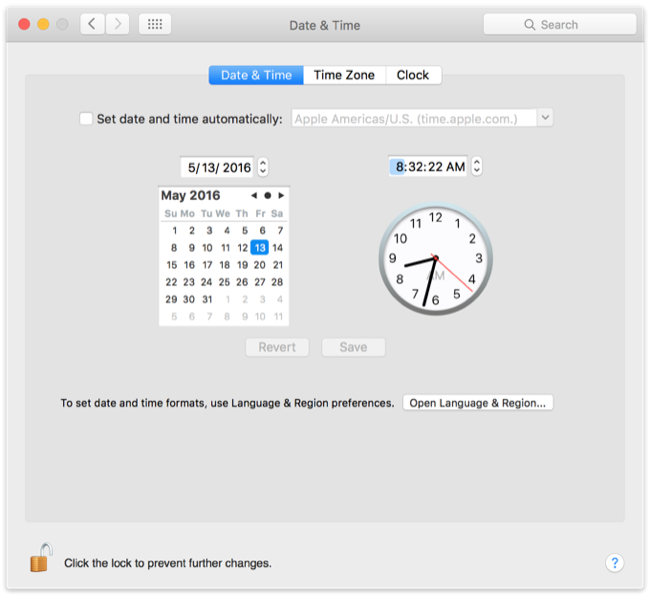
Now your Mac thinks it’s always in your home time zone and all the events in your calendar continue to display at their originally scheduled times.
Disable iOS Automatic Time Zone Switching
Your iOS device may automatically change your time zone when you travel, causing all the events in your calendar to shift. To avoid this you can turn off the automatic time zone setting on your iOS device in Settings > General > Date & Time.
Option 3: Schedule Events in Floating Time
As an alternative to scheduling events for a specific time zone, you can schedule events in Floating time. An event scheduled at 9:00 AM Floating time, appears at 9:00 AM in all time zones.
This may be useful if you are located in New York (US/Eastern) and are sending a meeting invitation to a client in San Francisco (US/Pacific) for a face-to-face meeting. If you schedule the lunch at noon Eastern and email the invitation to your client in San Francisco, the lunch appointment appears at 9:00 AM on your client’s computer. However, if you schedule the appointment for noon Floating time, the event displays at noon regardless of what time zone you are in. Then, when you travel to San Francisco to meet with your client, you’ll both show up for lunch at noon, regardless of what time zone is set on each computer.
On the other hand, if you’re scheduling a conference call with your client in San Francisco while you are in New York, you should not use Floating time. You’ll want each participant in the conference call to see the event in their local time zone, since a call scheduled for noon Eastern occurs at 9:00 AM Pacific.
Warning: Floating times are not supported by Exchange or Google Calendar. If you are syncing with Exchange or Google Calendar, you should not use Floating time events. Floating times are supported by BusyCal for iOS. And, although the iOS built-in Calendar app (Apple Calendar) doesn’t enable you to create Floating time events, it does let you view and edit such events created on macOS or iOS version of BusyCal.
Displaying Time Zones on the Info Panel
If you want to display or change the time zone for an event, you can choose BusyCal > Settings > Info Panel, and select the Start Time Zone and End Time Zone options.
If you enable the Start Time Zone, a single “time zone” pop-up menu displays below the event end time. A single “time zone” pop-up menu is sufficient for events that begin and end in the same time zone, like a conference call that is being scheduled for 9:00 AM Pacific and noon Eastern.
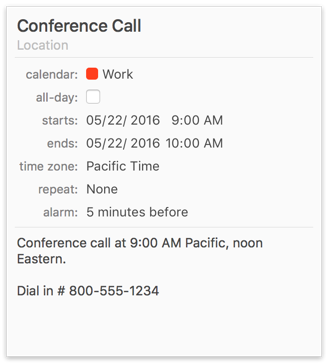
If you enable the End Time Zone field, separate pop-up menus appear for the start and end time. This is useful if you are scheduling an event that spans time zones, like a cross-country flight that departs at 9:00 AM Pacific and arrives at 5:00 PM Eastern.
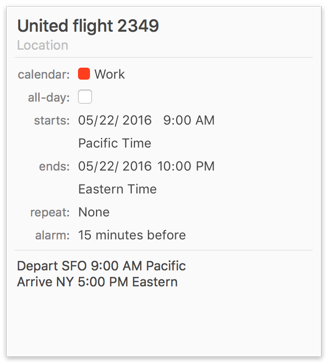
Google Calendar Time Zones
If you are syncing with Google Calendar and events are appearing in the wrong time zone (such as GMT), you may have a time zone setting misconfigured on Google. Log in to Google Calendar on the web, and verify that the global and per calendar time zones are correct. Here’s where to set the time zones on Google:
- Global setting: Google Calendar > Settings > General > Your current time zone
- Per-calendar setting: Google Calendar > Settings > Calendars > calendar name > Calendar Time Zone
After that, new events you create should have the correct time zone set. Existing events may need to be edited for them to get their time zones updated. The easiest way to do that is to unsubscribe from the calendar by double-clicking it in the left sidebar to open the Calendar Info dialog, and clicking Unsubscribe. Then resubscribe to the calendar by checking it in the left sidebar.
Favorite Time Zones
If you work with people in several Time Zones or frequently travel between multiple Time Zones, the "Favorite Time Zones" feature is for you. This was added to version 2022.4.7.
To add a set of frequently used time zones (a.k.a Favorite Time Zones), open BusyCal Settings > Advanced > Time Zones
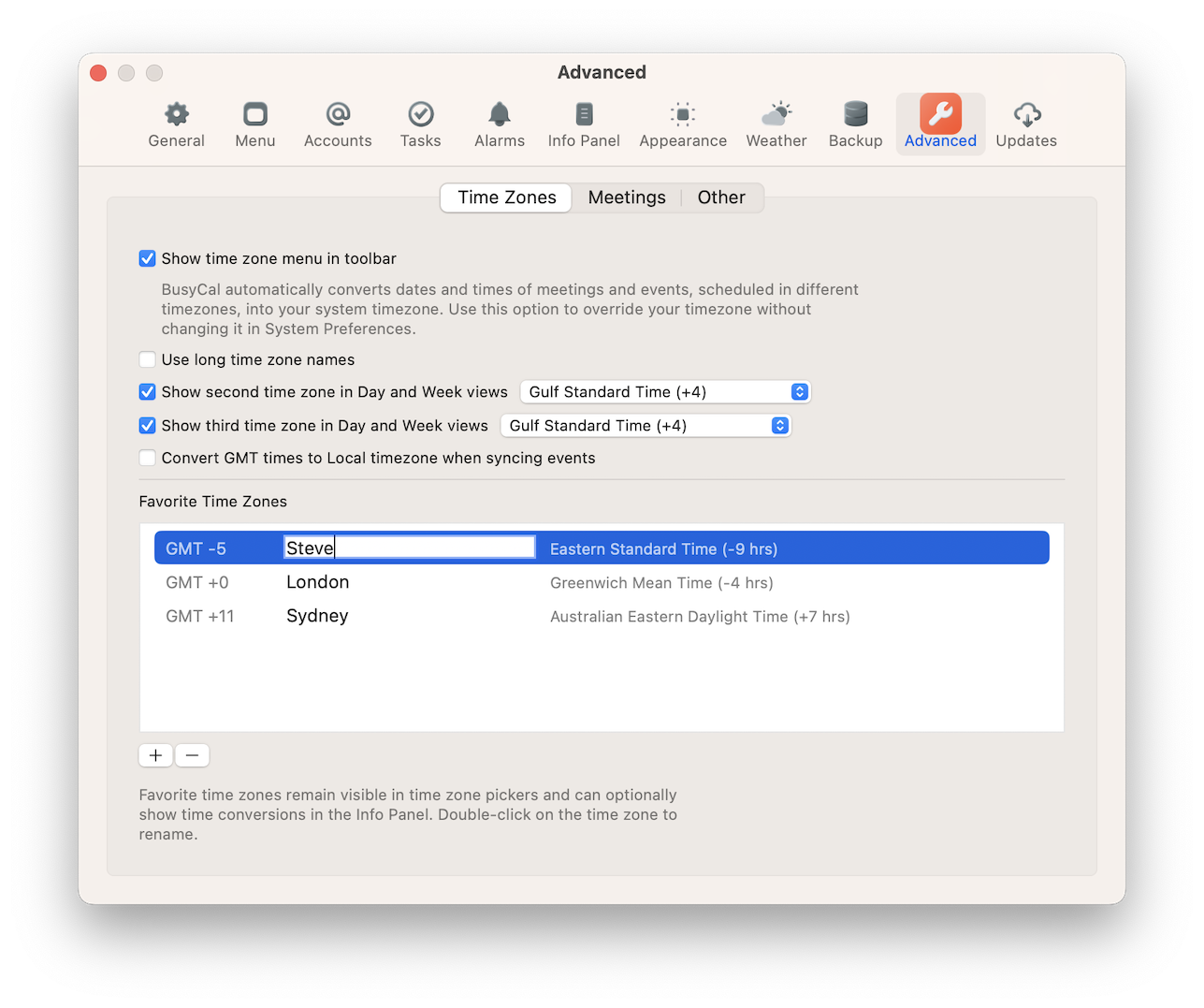
Click [+] to add a time zone. Double-click on its title to give it a custom name.
Any time zones you add here will show up in time zone pickers / popups across the app, and will optionally show a Time Zone Conversion card within the Info Panel. You can enable or disable this from under Settings > Info Panel > Favorite Time Zones
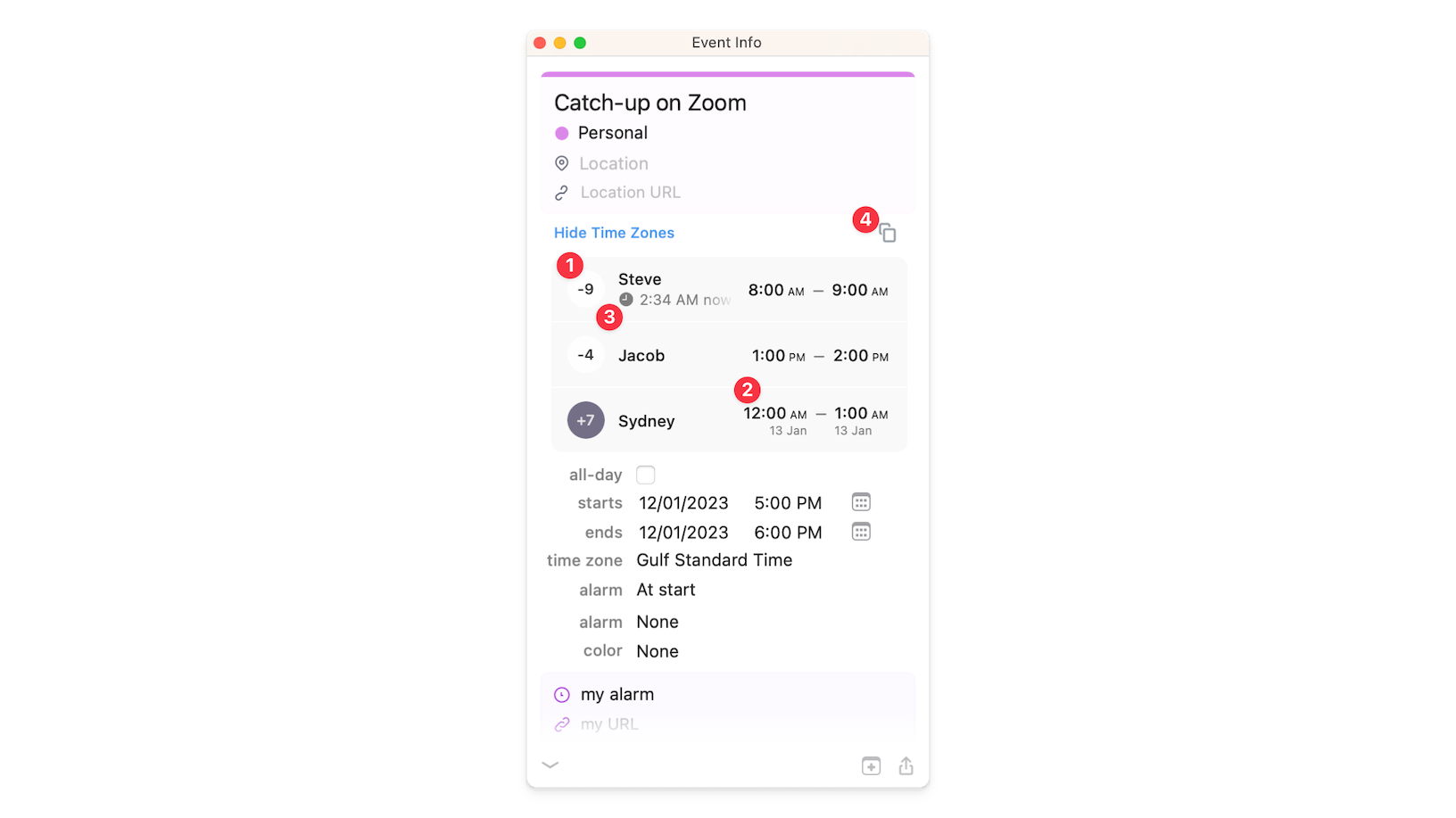
(1) Is the hour-offset from your current time zone. A dark background means it's evening time at the location, and a light background means it's daytime.
(2) Displays converted times
(3) Mouse-over the time zone's name to see current time at the location
(4) "Copy to clipboard" copies the schedule to your clipboard
Option 4: Adjust Events to Local Time Zone
This is for those situations where you did not use any of the options mentioned above, and when you arrive back home, all events are now showing in the original time zone in which they were created (i.e., they all seem wrong). If you wish to see them in your local time instead, you can:
- Select all of the affected events (CMD + click individually).
- Right-click / CTRL + Click on one of the selected events, and from the context menu, select the Adjust to Local Time Zone option.
This action will switch the event's time zone to match your current local time zone without altering the actual time of the event. For example, if your event was scheduled at 3 PM Paris time, and you're in the New York time zone, it will be adjusted to 3 PM New York time.